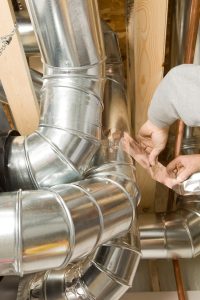Poor indoor air quality is a serious problem that impacts both healthy and unhealthy people. We spend many additional hours indoors during the winter, and breathing in polluted air can create respiratory irritation and shortness of breath for those with severe respiratory problems. Even those not at risk of having a negative response to allergens and irritants can experience respiratory aggravation. The current state of your respiratory health will determine how at risk you are for complications from poor IAQ. Poor IAQ is the equivalent of indoor air pollution, and depending on your health, it can cause a variety of health concerns.
3 Indicators You Should Test Your Indoor Air Quality
Indoor air quality (IAQ) is not a new term or idea, but you have likely heard it everywhere lately. While it may seem like a buzzword, you should stop and take a moment to assess why issues of indoor air quality have never been more critical. With cold and flu season right around the corner, you should get firm control over the state of your home’s air quality and ensure that you aren’t making an error that is worsening your air quality. Or, maybe your IAQ is perfect and you are doing everything right. Whatever the situation may be, we provide some ideas for knowing if your home needs air purification to improve the quality, and we provide tips on how to proceed to solve the problem.
You can begin to control the indoor air quality in your home and find the perfect solution by looking for these signs of bad air quality:
- Humidity – Some older heating and cooling systems can have a great deal of difficulty maintaining the moisture levels in your home. Imbalanced moisture is harmful to your home and the air quality in it. Moisture problems can also lead to mold growth. If you have a newer HVAC system, the moisture control issues could signal you have air leaks and imbalances in fresh and treated air.
- Stale Air – A home can smell musty and stale if you have a mold problem. Mold spores in the air can be hazardous to your respiratory health. Mold poses a severe threat to indoor air quality. Stale air can be a ventilation problem combined with mold spores. Eliminating the dampness and mold is a significant first step toward improving stale air, but effectively removing it will require a trained professional. A specialist can inspect your home, find the mold source, and eliminate the source of dampness.
- Dirty HVAC Unit – An HVAC system has an internal filter that removes allergens, dirt, and particles from the air in your home. If your air quality is still poor after filtering, then the problem could be in your HVAC ducts or warrant a more robust filtering system or air purification unit. If your filters and ducts are dirty, the dirt and air are being mixed and transported throughout your home.
Installing High-Quality Products to Improve IAQ
Individuals with pre-existing conditions like heart disease or upper respiratory issues are more susceptible to problems from subpar indoor air quality. Children and elderly persons are at greater risk of complications from long-term exposure to indoor air pollution than healthy adults. There are many health problems linked to contact with indoor pollution, and long-term exposure can lead to significant issues and respiratory illnesses. It’s crucial to begin tackling indoor air quality concerns as soon as you realize there is a problem.
Substandard air quality in your home or business can harm your health and cause:
- Chronic Headaches – Persistent headaches unassociated with any other illness you’ve suffered could be attributed to polluted air in your home if you notice they only happen at home. Headaches could be caused by allergies or mold, but regardless of the cause, you should note any linked symptoms and speak to your medical provider to determine a cause.
- Enduring Cold Symptoms – Coughs and sneezing that don’t go away and start when you spend time at home can be attributed to your home’s IAQ. These symptoms can be a sign that your heating and cooling system may need help filtering out allergens or mold spores.
The specialists at Coventry & Gattis Air Conditioning, Inc. are trained and licensed to install and maintain many of the newest leading technologies that provide excellent indoor air purification. Specifically, the new REME-LED™ technology used in products like the REME HALO® system can be easily incorporated into your current HVAC system, where it can kill 99% of viruses on surfaces and eliminate indoor pollutants.
Why Coventry & Gattis Air Conditioning, Inc.
The specialists at Coventry & Gattis Air Conditioning, Inc. are trusted professionals serving the residents of Grapevine, Texas, and surrounding communities. We are proud to offer our customers a robust selection of solutions that make your home a safer and better place to live. We have been in business for almost five decades, and over this time, we have been committed to providing our customers with the highest level of quality care, service, and products.
Our team of NATE-certified experts is trained and equipped to provide and manage your indoor air quality products and services. Coventry & Gattis Air Conditioning, Inc. delivers specialists committed to total customer satisfaction, and we do all this at a price you can afford.
If you think your home air quality could be improved or have questions about how IAQ solutions could enhance your house’s livability, call us at (817) 242-4888. We can answer all of your IAQ questions. We can’t wait to serve you!
Continue Reading
Tags: Indoor Air Quality
Posted in Indoor Air Quality | Comments Off on How to Tackle Indoor Air Quality Concerns This Winter


